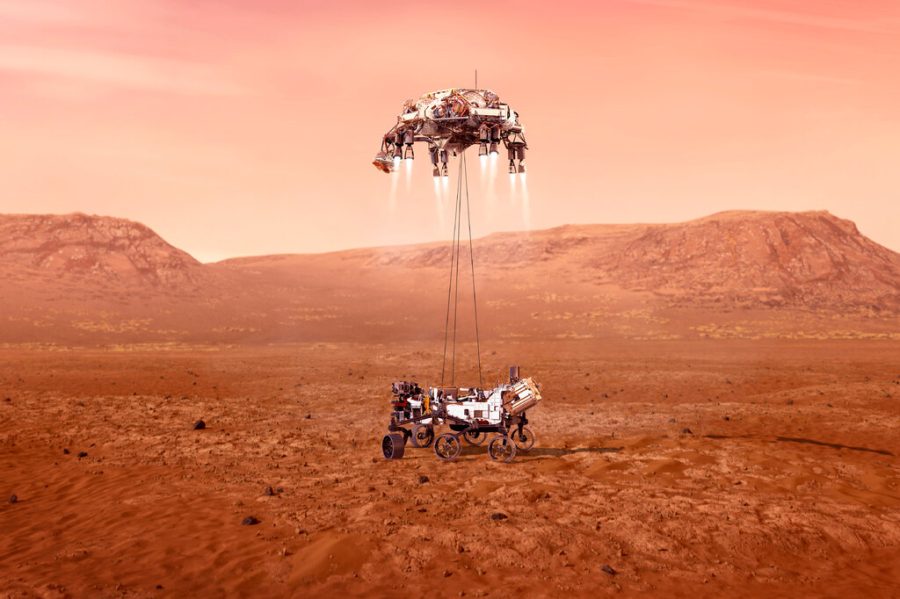Mars venture signals the triumph of science
May 4, 2021
Millions of years ago, humanity had just begun experimenting with sticks and stones. Now, we are exceedingly close to putting a man on another planet, potentially passing another historic rung on this arduous ladder of human advancement. On February 18, we became one step closer to achieving that goal. As a culmination of thousands of hours of development, years of dedication, and billions of dollars, Perseverance became the fifth successful rover to land on Mars.
The rover departed Earth in late July 2020 and spent close to seven months in space. The spacecraft carrying the rover was to touch down in the crater Jezero, once a vast lake, described as topographically similar to Lake Tahoe. The placement of the rover in the vestiges of this great lake was anything but accidental. In our own world, dried up lakes and rivers contain sediment that can hold evidence of ancient microbial life, and scientists hoped that on Mars, this could be similarly determined through the presence of certain organic compounds and fossil-like structures. However, this was all contingent on the rover’s success.
NASA estimated Perseverance’s landing to the minute. The precision of this measurement produced a window of immense anxiety. NASA could not be sure of what would happen. Would the rover crash and burn or land softly on the ground? Although the measurements were precise, the variables were significant; only 40% of similar missions had succeeded before.
I watched my computer screen in anticipation as I heard, in the midst of short breaths, cheers erupt and engulf the room. The mission was a success in all regards. I would proclaim it as one of the greatest and most exciting technological feats of the 21st century. The sheer distance that this operation encompassed emphasizes the true measure of the accomplishment. The Earth is over 150 million miles away from Mars. Thus, the spacecraft’s position could not be collected in real-time, meaning humans could not control it. Humanity had to place its faith in artificial intelligence programs that, if they’d misinterpreted even a single variable, would have resulted in the mission’s utter failure.
The mission as a whole stood behind a foundation of highly educated speculation. However, the hypothetical aspects do not diminish the achievement but lay testament to how incredible the event was. In our science classes, we work to test experiments that involve just a few variables. Often, at least in my experience, these labs run awry because we commonly omit or fail to consider a variable. Now imagine the scope of those experiments magnified exponentially. We would be dealing with millions of potential errors, outcomes, and unknowns.
Even with their previous successes, NASA could not account every variation, for every possibility; mechanical failures or miscalculations were an ever-present threat. The replication of the rover, a complex machine, would not just happen overnight. Moreover, the analysis to determine the root of the rover’s downfall would be another matter. In reality, if this mission failed, NASA’s next chance would not present itself until years later. The livestream of the rover’s descent, replete with desperate pleas of those who should hold the most confidence in it, reflected that assertion.
Perseverance is not simply a replica of past models. It includes a particularly fascinating modern addition: the drone. Attached to the rover’s underside, the drone has the purpose of surveying the terrain. More interestingly, it will seek to be the first aircraft to fly on another planet—an almost simplistic idea until we consider that man has yet to even set foot on the planet, let alone move on it.
In a larger context, this rover is part of an operation broken into three distinct segments: the gathering of sediment samples, the retrieval of them, and the transportation of them back to Earth. Each step will involve multiple smaller ventures, which will take a minimum of a decade to accomplish. The intent of this lengthy mission is to bring home a taste of the red planet—to take samples of sediment from Mars back to Earth to determine if life on Mars exists, or once did.
The conversation surrounding life outside of this planet has always been contentious. The idea that we are alone in our universe is almost mathematically improbable. I choose not to believe it. Somewhere in spaces’ vast expanses, trillions of galaxies, countless solar systems, and innumerable planets, life has to exist. Whether this rover marks the beginning of a new era or the continuation of our quest to prove we are not alone in this universe, Perseverance presents possibilities.

